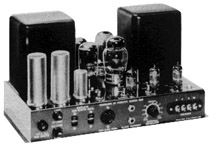 |
Grommes 260A mono power amplifier |
|
SPECIFICATIONS (furnished by manufacturer): Power output: 60 watts; with 120 watts peak. Distortion: 0.1% harmonic and 0.2% intermodulation at 30 watts; less than 0.5% harmonic and 1% intermodulation at 60 watts (all distortions under 0.1% at 20-watt level or less). Frequency response: ±0.5 db, 5 to 50,000 cps (attenuated beyond 100,000 cps). Power response: ±0.5 db, 20 to 20,000 cps at 60 watts. Controls: (4) Input gain; output balance; bias; DC balance. Output impedance: 4, 8, and 16 ohms from terminal strip. Hum and noise: 95 db below output. Size: 14" x 8¼” x 8". Price: $106.62. MANUFACTURER: Grommes - Division of Precision Electronics, 9101 King St., Franklin Park, Ill. At a glance: The Grommes 260A is a single-channel power amplifier rated at 60 watts output. Under operating conditions specified below, our measurements indicated a power output of 48 watts, but the full undistorted power of the amplifier can be realized throughout the entire audio spectrum, The distortion of the 260A, both intermodulation and harmonic, is extremely low at all output levels up to its maximum, and also at the lowest frequencies. In detail: No attempt has been made to make the Grommes 260A a "compact" amplifier. It is large, solid, and very heavy. The pair of 6550 output tubes, plus the pair of 5U4G rectifiers, the 6L6G screen voltage regulator, and the bias supply regulator all suggest that this amplifier should deliver its rated 60 watts or more without difficulty. We were, therefore, somewhat surprised to find that it would put out only some 48 watts (a second unit provided about the same power). The instruction sheet accompanying the amplifier supplied a clue: the 260A comes equipped with adjustments for individual output tube currents, and these were set at the nominal 55mA level suggested in the instructions. It was stated that this could be increased to 60mA to increase the output, at the expense of tube life, or reduced to 50 ma, to prolong tube life. We believe that longer tube life is worth the sacrifice of a few watts; so we left the original adjustments unchanged.
IM distortion was below the measuring capabilities of our instruments up to about 5 watts output, and only reached 0.5% at 50 watts. Harmonic distortion at 1,000 cps was well below IM distortion at all power levels. Most gratifying was the 20-cps harmonic distortion, which was almost immeasurable up to 10 watts, and at 40 watts reached only 0.4%. In our experience, only one other power amplifier has produced so little distortion at this frequency. The square wave response, to a 10- kc square wave, was not very pretty. At slightly above 20 kc, a pronounced ringing could be seen with an amplitude almost 20% of the square wave itself. This, however, does not denote the presence of any instability or incipient oscillation, as it sometimes does in power amplifiers. Placing any capacitive load, even our 3-mf simulated electrostatic speaker, across the output had no effect whatever on the square wave response. We could not find any evidence of it in listening tests, nor would we expect to in view of the ringing being well outside the audible frequency range. Hum level was totally inaudible, being between 80 and 90 db below 10 watts output depending on the gain control settings. In part, the Grommes 260A is a survival of the time—only a few years ago—when amplifiers with a variable damping factor were in vogue. This feature has happily disappeared from most amplifiers today. We did not attempt to evaluate the DF control, but would not be surprised to find that it has something to do with the peculiar square wave response we observed. Incidentally, we did find some considerable differences in the maximum power output at the various output taps. All our measurements are normally made at the 8-ohm tap, but we found that some 55 watts could be obtained at the 16-ohm tap. Considered without regard to whether it is a 48-, 55-, or 60-watt amplifier, the Grommes 260A emerges as one of the finest power amplifiers made, by virtue of its rugged, conservative construction, and remarkably low distortion. Hirsch-Houck Laboratories. |
|||
 Taken
from High Fidelity magazine, February 1960
Taken
from High Fidelity magazine, February 1960 Both
the power- and frequency-response curves were drawn with a straightedge
over most of their length. One expects a power amplifier to have
flat frequency response, but not many will deliver their full power
from 20 to 20,000 cps—as the Grommes 260A does, without fuss
or strain.
Both
the power- and frequency-response curves were drawn with a straightedge
over most of their length. One expects a power amplifier to have
flat frequency response, but not many will deliver their full power
from 20 to 20,000 cps—as the Grommes 260A does, without fuss
or strain.